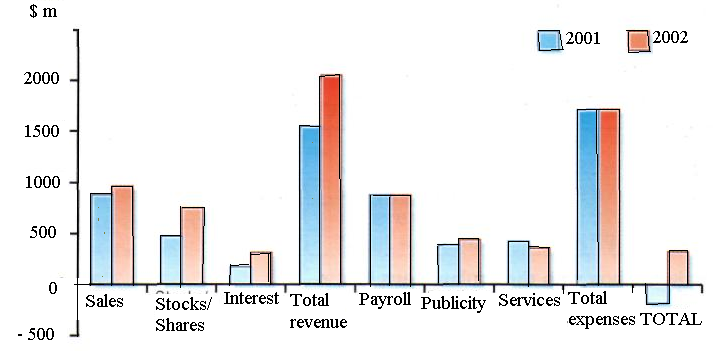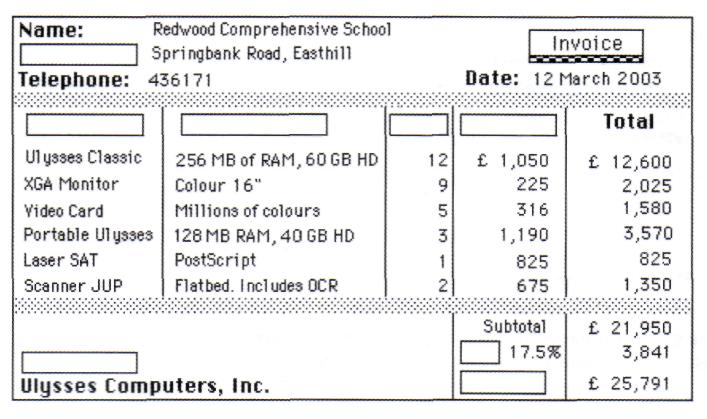
- •4. Look at the words in the box and complete the following sentences with them. Use the information in the text or Glossary if necessary.
- •5. Match the words and expressions on the left with their explanations on the right.
- •6. Find English equivalents for these words in the text:
- •II. Listening
- •1. Two friends are talking about how to move text by using the 'Cut and Paste' technique. Read the conversation and complete it with words from the box.
- •V. Writing
- •VI. Speaking
- •VII. Listening: Spreadsheets
- •Unit 10
- •3. Using the information in the text, complete these statements.
- •II. Grammar: Plurals
- •1. Study this information:
- •Write the plural of these words:
- •4. Puzzle
- •III. Listening
- •1. Listen to Helena Davies, an it trainer, explaining how to use mail merging to some employees. Number these steps in the order that you hear them.
- •2. Look at the illustration of mail merging and identify the three types of documents involved in this example of mail merging.
- •IV. Writing
- •1. Study this sample mail:
- •V. Listening
- •1. Try to answer these questions.
- •Listen to a conversation between a customer buying a pc and a sales assistant. Why do you think the sales assistant has to explain so much about the Internet?
- •Listen again and complete the customer’s notes.
- •VI. Reading: Internet software
- •1. Which Internet utility (1 to 7) would you use to do each of these tasks (a to g)?
- •2. Read the text to check your answers.
- •3. Read the text again and choose the right answer.
- •2. Look at these tasks and choose the most suitable Web site from the cyberlist.
- •3. Rearrange the letters to create the words described.
- •IX. Reading/ Speaking: Online
- •Read the interview below with a best-selling author Jessica Adams about her experiences with computers.
- •Complete the interview by matching the questions (a-l) below with the appropriate gaps in the article (1-12) in 1.
- •3. Work with a partner. Ask the questions from the interview.
- •X. Translation. Translate this text into Ukrainian.
- •XI. Writing: Dos and don’ts
- •4. Do you agree with the point of view of the author? Why/Why not?
- •5. Prepare a speech (up to 1 minute) to express your point of view.
V. Writing
You have run your letter text through the spellchecker. Unfortunately, it missed a number of mistakes. Identify all 20 mistakes and correct them. Write the correct version in your notebook.
I’d really like to complement you on you’re new product line/ I think its grate that you’ve mad it available for the Mac, to. Are they’re any features on the PC version that are not on the one four the Mac? At the monument, we are planning too order a set of programmes this autumn, if hour test results are positive, of coarse. However, we cannot except the terms and conditions as they are know. Whose responsible for setting the prizes? Although we are very interested in the software, weather we buy it or knot may depend on the cost.
VI. Speaking
Work in pairs. Read the table below which summarizes the most relevant features of two word-processing programs. The characteristics of each program are marked with a tick (√). Student A has Printext and Student B has Publisher. Explain to your partner why your program is better.
Example
a: With Printext I can ...
b: Yes, but you can't ...
a: However, it is possible to ... whereas with Publisher you can't ...
B: Yes, but don't forget that with Publisher you can ... Moreover, ...
a: OK. I understand what you mean, but what about ...?
Characteristics |
Student A “Printext” |
Student B “Publisher” |
1 Instantaneous WYSIWYG and editing |
√ |
√ |
2 Variety of font types, styles and size |
√ |
√ |
3 Editing facilities: Copy, Cut, Paste, Undo, Select All |
√ |
√ |
4 Centering and indenting paragraphs. Special column formats. Hyphenation and justification of text with optimum line-breaking |
√ |
√ |
5 Spell checker, grammar checker and thesaurus |
√ |
√ |
6 Can find and replace words even in unopened files |
√ |
|
7 Automatic numbering of chapters and sections. Automatic generation of indexes and tables of contents. Cross-reference facilities |
|
√ |
8 Allows you to generate maths formulas, and diagrams |
|
√ |
9 Graphics tools: You can have the text wrap around the graphic or flow through it. You can scale and rotate graphics |
√ |
|
10 Import and export facilities. You can transfer files to other IBM PCs and Macintosh applications |
√ |
|
11 You can record voice annotations to insert comments into a document |
|
√ |
12 Includes Internet connection tools and allows you to create HTML pages for the Web |
|
√ |
VII. Listening: Spreadsheets
1. Look at this spreadsheet and answer the questions. (This sample spreadsheet shows the income and expenses of a company. Amounts are given in $millions).
What is a spreadsheet? What is it used for?
In a spreadsheet, there are 'columns', 'rows' and 'cells'. Give an example of each
from the sample spreadsheet.
What type of information can be keyed into a cell?
What will happen if you change the value of a cell?
|
R |
B |
C D |
D |
E |
1 |
|
2001 |
2002 |
|
|
2 |
Sales |
$890 |
$982 |
|
|
3 |
Stocks/Shares |
487 |
768 |
|
|
4 |
Interest |
182 |
324 |
|
|
5 |
Total Revenue |
1559 |
2866 |
|
|
6 |
|
|
|
|
|
7 |
Payroll |
894 |
984 |
|
|
8 |
Publicity |
399 |
451 |
|
|
9 |
Seruices |
438 |
372 |
|
|
18 |
Total Expenses |
1731 |
1727 |
|
|
11 |
|
|
|
|
|
12 |
TOTRL |
-172 |
339 |
|
|
13 |
|
|
|
|
|
14 |
|
|
|
|
|
2. Listen to Lucy Boyd, a software developer, talking about spreadsheet
programs and the spreadsheet above and check your answers to Task 1.
3. Listen again and decide whether these sentences are True or False:
1. A spreadsheet program displays information in the form of a table, with a lot of columns and rows.
2. In a spreadsheet you can only enter numbers and formulas.
3. In a spreadsheet you cannot change the width of the columns.
4. Spreadsheet programs can produce visual representations in the form of pie charts.
VIII. Vocabulary
1. Translate and match the terms in the box with the explanations below.
a. formula b. cell c. sales d. payroll e. share(s) f. revenue
1 A sum of money that is charged or paid as a percentage of a larger sum of money which has been borrowed or invested,
e.g. High … rates;17per cent … on a loan.
The intersection of a column and a row in a spreadsheet,
e.g. the … B2.
The quantity sold,
e.g. The … of PCs rose by 10 per cent last year.
The income – or money – received by a company or organization,
e.g. The annual … of this multinational company is ...
5 A … in a company is one of the equal parts into which the capital of the company is divided, entitling the holder of the … to a proportion of the benefits,
e.g. ₤10 …s are now worth $11.
Financial costs; amounts of money spent,
e.g. Travelling ….
A function or operation that produces a new value as the result of adding, subtracting, multiplying or dividing existing values,
e.g. If we enter the … B5-B10, the program calculates ...
1 A list of people to be paid and the amount due to each.
2 Wages or salaries paid to employees,
e.g. He was on the company's ….
2. Look at the graph and, with the help of a partner, check that it is an exact visual representation of the spreadsheet in Task V.

3. What type of image is this: a pie chart, a bar chart, an area graph or a line graph? Say what is the advantage, if any, of displaying information as a graph, rather than as a spreadsheet?
4. Spreadsheet programs are also used to make out invoices. Look at the invoice below. Copy it and fill in the blanks with the right words from the box.
Quantity Description Price VAT (Value Added Tax) Reference TOTAL Address Company

